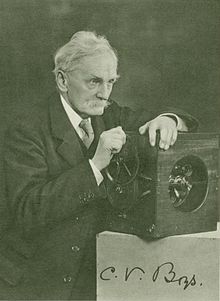Charles Boys
Sir Charles Vernon Boys , FRS (born March 15, 1855 in Wing in Rutland , England , † March 30, 1944 in St. Mary Bourne , Andover in Hampshire ) was an English physicist.
Boys was the son of a minister, attended Marlborough School and the Royal School of Mines . While still in school, he invented a device for mechanical integration , which he described in Philosophical Magazine of 1881. After a short time in coal mining, he accepted the offer of his physics professor Frederick Guthrie and became his assistant. He became known for the invention of suspensions made of quartz fibers in measuring instruments, which he used, for example, for a measuring instrument for thermal radiation and for repeating the Cavendish experiment to determine the gravitational constant (Philosophical Transactions of the Royal Society 1895). Boys also took photographs of fast-moving objects such as bullets and lightning bolts. His Faraday Lectures on Soap Bubbles have been published as a book and are considered classics in physics literature.
In 1888 he became a Fellow of the Royal Society . From 1889 to 1897 he was an assistant professor at the Royal College of Science in South Kensington . In addition, he was an auditor for the University of London and from 1887 consultant of the city gas works, where he made investigations into the calorific value of the gases. In 1939 he retired and moved to the countryside, where he grew weeds and wrote a book about them.
He had been married since 1892. The marriage had two children but ended in divorce in 1910 following a Cambridge university scandal . His wife had a relationship with the mathematician Andrew Russell Forsyth , who then had to leave Trinity College, which also caused his friend Alfred North Whitehead to leave Cambridge.
During the summer vacation of 1900 on the Channel coast, he observed a thunderstorm and wondered where the lightning actually starts, where the jerks come from and how the lightning bolt grows. He designed a photo camera with a stationary photo plate and two lenses rotating around a horizontal axis. A hand crank with a large gear ratio served as the drive. Boys immediately broke off his vacation, rushed home, and set about designing the camera that bears his name. Relatively soon he was able to take a picture that showed that a flash consists of several partial flashes. Although he took this camera with him on all his travels, he was unable to take another picture. In 1927, during a visit to Basil Schonland , he told about his camera. During a further visit four years later, he lent it to Schonland, which was able to take many pictures with it that showed the relatively slowly growing guide light (pre-growth speed around 1/30 C) and the main beam running in the opposite direction (pre-growth speed around 1/5 C) .
In 1896 he received the Royal Medal of the Royal Society and in 1924 their Rumford Medal . In 1925 he received the Duddell Medal of the Physical Society of London (today: Institute of Physics ), of which he was president in 1916/7. He was a member of the New York Academy of Sciences and the Moscow Physical Society. In 1935 he was knighted as a Knight Bachelor . In 1936 he became an Honorary Fellow of the Royal Society of Edinburgh . From 1906 to 1907 he was president of the Röntgen Society. In 1903 he was president of the mathematical and physical section of the British Association . In 1932 he was awarded an honorary doctorate from the University of Edinburgh .
Fonts
- Soap bubbles - their colors and the forces which mold them , 1890, Dover 1990, ISBN 0-486-20542-8
- Weeds, Weeds, Weeds , London, The Old Westminster Press, Wightman and Co., 1937 (his book on weeds)
swell
- ↑ electrosuisse.ch: Sir Charles Vernon Boys (PDF; 31 kB)
- ^ Biographical Index: Former RSE Fellows 1783–2002. Royal Society of Edinburgh, accessed October 11, 2019 .
Web links
- John J. O'Connor, Edmund F. Robertson : Charles Boys. In: MacTutor History of Mathematics archive .
| personal data | |
|---|---|
| SURNAME | Boys, Charles |
| ALTERNATIVE NAMES | Boys, Charles Vernon (full name) |
| BRIEF DESCRIPTION | English physicist |
| DATE OF BIRTH | March 15, 1855 |
| PLACE OF BIRTH | Wing , Rutland |
| DATE OF DEATH | March 30, 1944 |
| Place of death | St. Mary Bourne , Andover , Hampshire |
